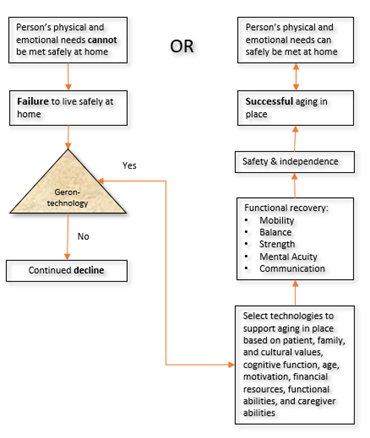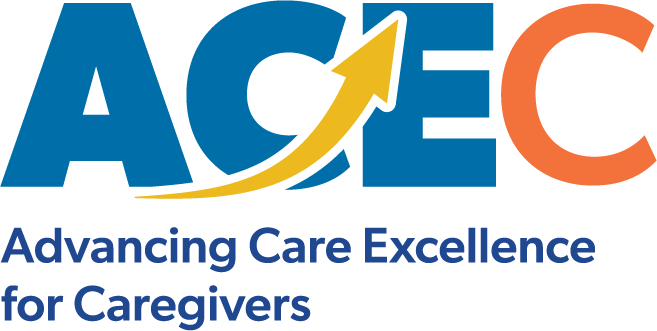Technology Support for Caregivers of Older Adults: Exploring Gerontechnology and Health Policy/Research Implications
This teaching strategy introduces students to a new interprofessional field of study called gerontechnology, an interprofessional academic and practice-based field combining gerontology and technology. Sustainability of an aging society depends on effectively creating technological environments that encompass the use of assistive technologies and inclusive designs for innovative and independent living. Such environments promote social participation of older adults in physical activity and the cognitive stimulation needed for healthy aging. In short, gerontechnology concerns the matching of technological environments to health, housing, mobility, communication, and the leisure and work of older people.
The teaching strategy will assist students to experience the core values of the National League for Nursing, which are caring, integrity, diversity, and excellence. The learning activities in this teaching strategy can be used for undergraduate and graduate students, separately or together. The teaching strategy can also be used as interprofessional activities to engage students from nursing, medicine, social work, physical therapy, and pharmacy as they brainstorm ideas about public health policy and research related to gerontechnology and learn about, from, and with each other. The learning activities can be used in class or online.
Technology Support for Caregivers of Older Adults: Exploring Gerontechnology and Health Policy/Research Implications
Download All Files for This Teaching Strategy
Learning Objectives
Students will:
- Identify the purpose and research initiatives connected to the interprofessional field of gerontechnology.
- Utilizing the Aging in Place Model, explore possible research studies that could be generated using this model.
- Based on the World Health Organization’s initiatives on assistive technology and aging in place, discuss research priorities and potential health care policies.
Learner Prework
Students can watch the following videos:
- Preparing the healthcare workforce to deliver the digital future. https://www.youtube.com/watch?v=zIBoOITkDDA
- Introduction to Gerontechnology: Part 1. https://www.youtube.com/watch?v=Y1T6qZOL_TQ
- Introduction to Gerontechnology: Part 2. https://www.youtube.com/watch?v=u5fje7M4DYM
- Introduction to Gerontechnology: Part 3. https://www.youtube.com/watch?v=YlOhgYqKgkA
- Introduction to Gerontechnology: Part 4. https://www.youtube.com/watch?v=Arr9E5v3SuA
Suggested Learning Activities
1. Interprofessional research activity
- Examine the new discipline called gerontechnology.
- Describe the professional organization and its mission.
- Identify the disciplines that participate in the organization.
- Discuss research initiatives or recent findings related to gerontechnology.
- Describe a possible research study that could be accomplished in the local community.
2. Health care policy activity
- Study the World Health Organization’s initiatives on assistive technology and aging in place.
- Assistive technology https://www.who.int/news-room/fact-sheets/detail/assistive-technology
- Global cooperation on assistive technology https://www.who.int/initiatives/global-cooperation-on-assistive-technology-(gate)
- Aging and health https://www.who.int/news-room/fact-sheets/detail/ageing-and-health
- Global strategy and action plan on aging and health https://www.who.int/publications/i/item/9789241513500
- Describe the two different initiatives and the overlap between the initiatives.
- Discuss the research priorities for assistive technologies.
- Identify potential health care policies for developed and developing countries.
- Describe the role of the United States in the World Health Organization as it relates to assistive technology.
3. Theory activity
- Study Figure 1 below.
- What possible research studies could be designed using the model?
- Select a technology to assist aging in place
- Outline how to implement the gerontechnology
- Identify appropriate outcome measurements using the model.
Figure 1. Aging in Place with Gerontechnology.

Suggested Reading
Chau, D., & Osborne, T. (2018). Using technology to improve care of older adults (Critical Topics in an Aging Society). New York: NY: Springer.
Demiris, G., & Hensel, B. (2009). “Smart homes” for patients at the end of life. Journal of Housing for the Elderly, 23(1-2), 106-115. https://doi.org/10.1080/02763890802665049
Hargreaves, T., Wilson, C., & Hauxwell-Baldwin, R. (2018). Learning to live in a smart home. Building Research & Information, 46(1), 127-139. https://doi.org/10.1080/09613218.2017.1286882
Mahmood, A., Yamamoto, T., Lee, M., & Steggell, C. (2008). Perceptions and use of gerotechnology: Implications for aging in place, Journal of Housing for the Elderly, 22(1-2), 104-126. https://doi.org/10.1080/02763890802097144
Majumder, S., Aghayi, E., Noferesti, M., Memarzadeh-Tehran, H., Mondal, T., Pang, Z., & Deen, M.J. (2017). Smart homes for elderly healthcare—recent advances and research challenges. Sensors, 17(11). https://doi.org/10.3390/s17112496
Author Information
Karen H. Frith, PhD, RN, NEA-BC, CNE
Professor and Associate Dean for Graduate Programs
The University of Alabama in Huntsville
Huntsville, AL
ACE.C Funding
ACE.C resources were made possible with generous funding from the John A. Hartford Foundation and the AARP Foundation.


